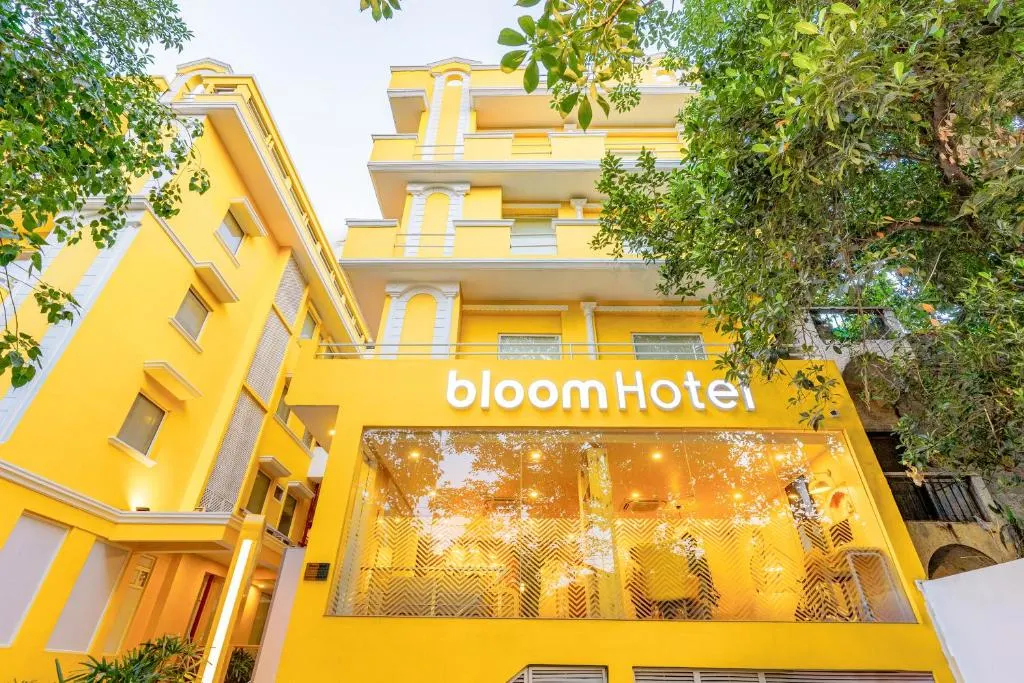While travelling recently, I saw some light yellow hotels that look quite inviting with Bloom written on them. When I looked them up online to see the rooms, I was quite impressed.
The founders teamed up with university professors, architects, and industry experts to build something solid. They identified a gap in the mid-market hotel space and decided to fill it with an outstanding product backed by smart technology. After a year-long deep dive into the market, the team concluded that long-term success would only come with a superior, tech-driven experience.
And that has been their differentiator in the crowded hotel industry.
This philosophy became their North Star for every marketing decision that followed. When other hotels were pushing amenities and square footage, Bloom focused on affordable luxury. They are also profitable with a revenue of INR 144 Cr in FY23!
David vs. Goliath in Hospitality
When Bloom entered the market, they were facing off against giants with marketing budgets that dwarfed their entire operating costs. Marriott, Hilton, and Hyatt had been playing the game for decades, with established brand recognition and massive distribution networks.
But Bloom’s marketing team saw this as an advantage, not a disadvantage.
Big hotel chains were stuck in their own success. Their marketing had become predictable – happy families in perfectly lit lobbies, business people in crisp suits shaking hands, generic stock photos of pools and conference rooms.
Vacation rentals through Airbnb were growing, but lacked the consistency and service standards that many travelers still wanted. Bloom positioned itself right in the sweet spot – consistent enough to trust, unique enough to remember. Their target demographic wasn’t defined by age or income alone, but by mindset.
These travelers wanted great experiences without the luxury price tag. They shared their experiences on social media. Most importantly, they were willing to pay a premium for hotels that “got” them. Because of their intentional approach, Bloom boasts one of the highest rates of direct bookings and repeat guests in the industry. (Source)
Brand Identity
Building a hospitality brand that stands out requires more than good design – it requires a personality that people want to be associated with. In the age of social media, every guest becomes a brand ambassador, whether they realize it or not.
This meant their brand identity had to be photogenic, but also authentic enough to not feel forced. The name “Bloom” itself suggested growth, freshness, and natural beauty without being too literal or limiting.
Unlike names tied to specific locations or founders, “Bloom”, with floral imagery, could expand geographically and demographically while maintaining brand coherence.
As Bloom expanded, so did their offerings. They now operate across three formats:
bloomrooms: Clean, consistent stays for business travelers
bloom Suites: More space and comfort for longer visits
bloom Boutique: Character-rich properties that preserve local heritage
Their visual identity walked the line between approachable and aspirational. The color palette drew from nature but felt modern and sophisticated. The typography was clean enough for digital applications but had enough personality to feel human.
Digital Marketing
While most hotel chains throw money at TV and print ads, Bloom took a more strategic approach: social-first marketing. They spent time figuring out where their audience hangs out online and tailoring content to fit those platforms.
Their focus was on trust, transparency, and speaking directly to their ideal guest – the savvy traveler who does their homework before booking. This lean, digital-first strategy helped Bloom go toe-to-toe with big hotel chains, even on a smaller budget. Instead of shouting loudly, they focused on building real engagement.
Bloom’s website became their most important marketing asset, serving as both a booking platform and a brand experience. The user experience was designed with the customer journey in mind. They also integrated a user’s browsing history to make the website content dynamically relevant to them.
This personal touch helps with more conversions. Email marketing became their secret weapon for building long-term relationships. They sent emails to customers with personalised offers for higher engagement and conversions.
They also partnered with OTAs like MakeMyTrip and Booking.com to increase their chances of being discovered by new people right where they’re searching. This dual strategy meant they could scale quickly while still maintaining control over customer experience and brand perception.
In terms of celebrity partnerships, they featured Rahul Dravid in an ad a year ago with the tagline “Bloom to your best.”
Recently, they partnered with Kriti Sanon for a more emotional positioning as “Home Away From Home”:
They also used the adjective “Bloomer”. Do you think it’s the beginning of an identity that loyal customers would like to refer to themselves as?
The company is also active on Instagram with all yellow branding and quirky reels that appeal to younger audiences:

A major focus is also collaborations:

Smart Growth: Quality Over Quantity
Bloom’s early strategy wasn’t about spreading fast – it was about getting it right. They focused on Tier 1 cities like Delhi, Bengaluru, and Goa, choosing only the best locations in each market. This helped them truly understand urban travelers and build a strong foundation.
They leveraged fair pricing, genuine service, clean environments, and no fake promises. In a segment known for overpromising and under delivering, this was a refreshing change. While others chased headlines and fast growth, Bloom chose to obsess over quality, even if it meant growing slower.
For them, it was better to wait for the right opportunity than to compromise on standards. In 2024, they had over 50 hotels across Tier 1 and 2 cities like Delhi, Udaipur, Pune.
Bloom’s decision to pick the best locations in every city was an ops call as well as a branding move. Their Janpath hotel in Delhi is a great example – set in a prime cosmopolitan area, it’s marketed not just for its amenities, but for its connectivity and accessibility.
Interestingly, it was also built in around 100 days, from contract to open for business. While others offer low rates in less desirable areas, Bloom offers premium locations at mid-market prices – and makes sure everyone knows it.
Key Takeaways from Bloom Hotels’ Marketing
Positioning around experience, not price or amenities, can set you apart even in saturated markets.
- A strong brand identity that’s scalable and emotionally resonant is more valuable than trend-based design.
- Digital-first, social-driven marketing can outpace traditional advertising when rooted in customer understanding.
Consistency across touchpoints builds long-term trust and encourages repeat purchases or bookings.
Smart product differentiation becomes a natural, memorable marketing hook.


